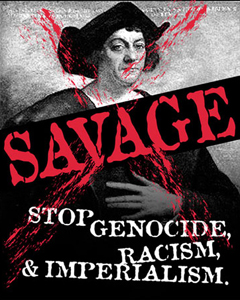Navajo Hipster Panties Gone Awry
By Arielle Zionts
“Some people don’t know that that’s offensive…you are desensitized to it,” said Scoggins.
McGowan agrees that education on the topic should be promoted, but warns that people should not be approached forcefully about the issue.
“You just don’t go up to them and say ‘hey, don’t do this’ because then you aren’t a good ambassador…because [by doing so] you are putting on an aggressive face yourself,” said McGowan.
Anthes hopes that the movement towards the acceptance of the LGBT community can be used as a model to approach this trend.
“Twenty years ago… it was acceptable societally to make homophobic jokes, to just assume that these people were not going to hear you say these hateful things… that population has become a lot more visible so we understand and have empathy,” said Anthes. “Most people [can] go through their life without ever having to look an Indian person in the eye and say… ‘it’s fine if I’m joking about it.’”
Arguably, the best way to combat the problem of cultural misunderstanding is through fostering intercultural connections. Native Americans are a minority of the American population, and can easily be marginalized. Efforts such as Adrienne K’s Native Appropriations blog and social media campaigns are where indigenous Americans can have their voices heard.
McGowan, who's "a senior at Claremont High School and a member of the Iowa tribe of Kansas and Nebraska," doesn't like the "in your face" approach. But we have only his opinion that it doesn't work. There's nothing resembling a fact to support his claim.
In any case, Adrienne Keene's blog often takes an "in your face" approach. As does my blog, of course. Many of the Native activists I know also take this approach.
And we have proof that this approach works: the Civil Rights movement of the '60s. Nothing was going to change until the National Guard integrated the schools, blacks occupied buses and lunch counters, and people marched in the streets. Same with Indians: Alcatraz, the Trail of Broken Treaties, and Wounded Knee II.
As someone said recently, smiles, prayers, and dances for unity aren't enough. If you want to change something, you often have to get angry and make yourself heard. America started acknowledging minority rights only when minorities thrust themselves in America's face.
For some recent protests, see McNairy Apologizes for "Manifest Destiny" T-Shirt and Winning the War on Columbus? For a discussion of protests in general, see Stereotypes Disappear "Organically"? and Do Protests Work?


1 comment:
Anti-AIDS activism tended to be very "in your face". There were pictures of erect penises and the caption "use a condom or beat it". That's as "in your face" as you can get. (TBH, some of them struck me as just a bit entitled. "Why is there no cure for this disease we've known about for less than a decade?" It took thousands of years to eradicate smallpox, and it wasn't by curing it.)
Being passive...doesn't work. You become less "in your face", and they want you to be even more passive. At the risk of Godwin, you give them the Sudetenland, they want Poland, France, Russia, all Europe, and then, they cross the English Channel.
Post a Comment